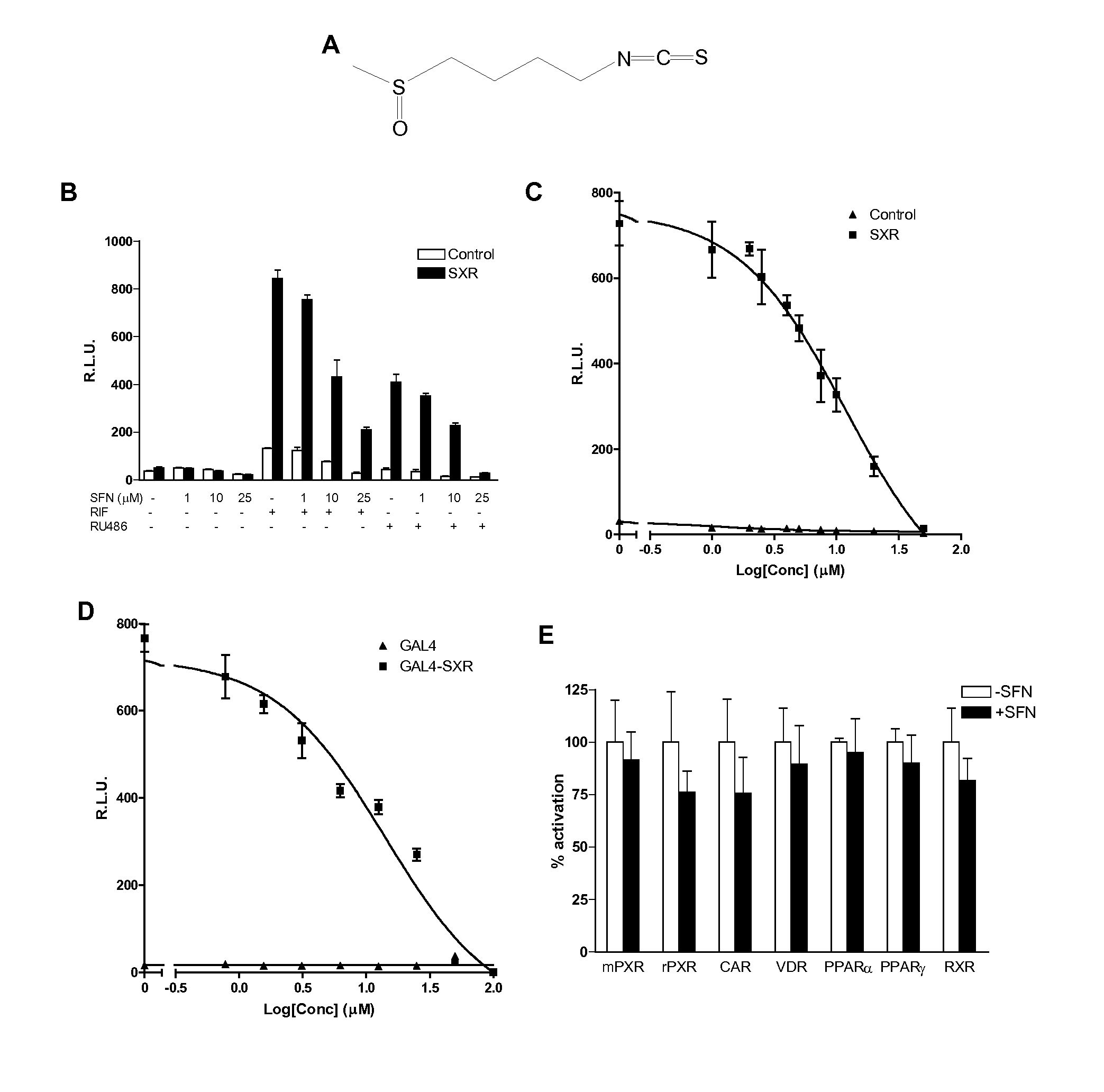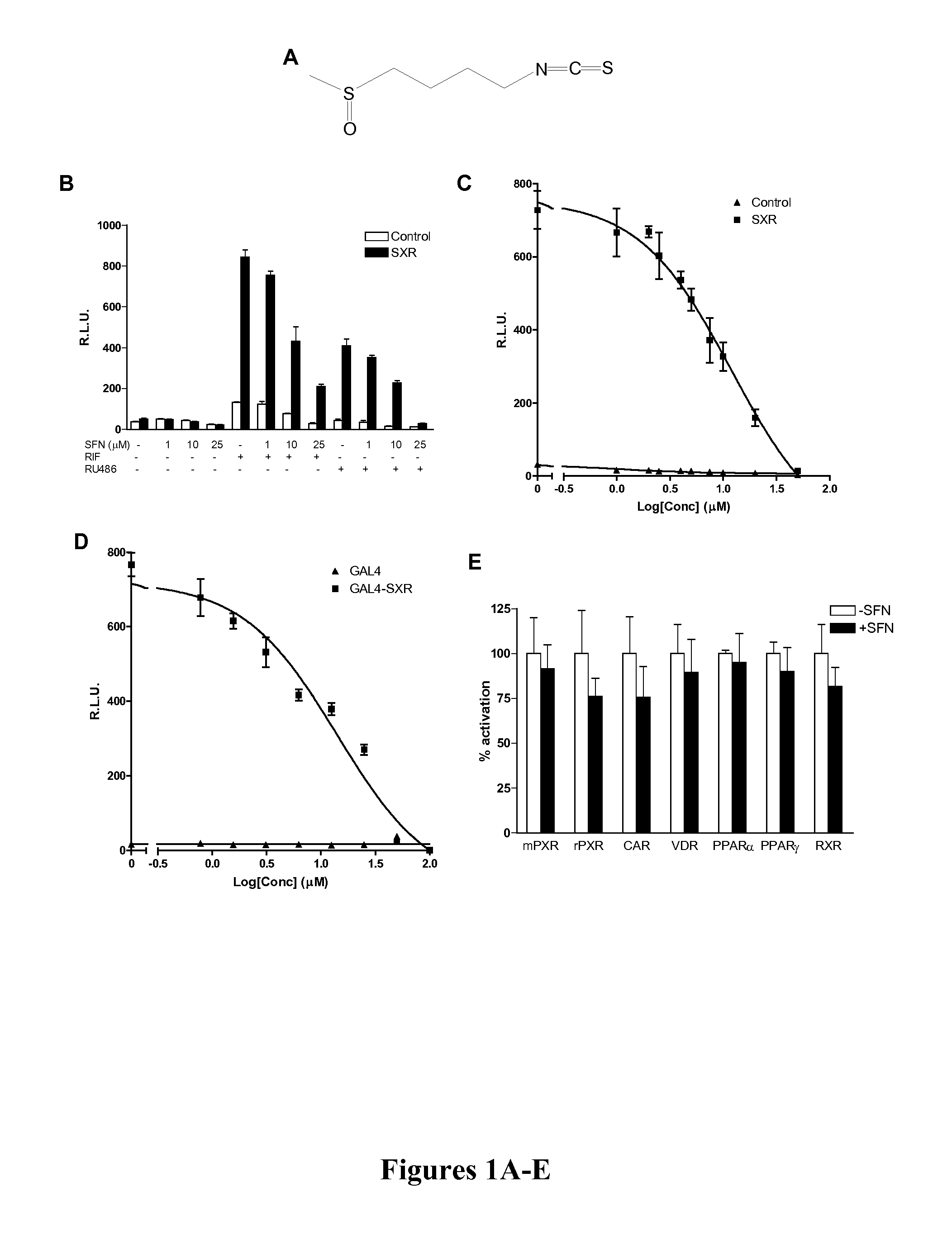Inhibiting cyp3a4 induction
a technology of cyp3a4 and induction, applied in the field of inhibiting cyp3a4 induction, can solve the problems of more than 100,000 deaths, and achieve the effects of inhibiting sxr-mediated induction, inhibiting cyp3a4 expression, and efficiently inhibiting sxr activities and sxr-mediated
- Summary
- Abstract
- Description
- Claims
- Application Information
AI Technical Summary
Benefits of technology
Problems solved by technology
Method used
Image
Examples
example 1
Reagents and Plasmids
[0085]SFN, Rifampicin (RIF), mifepristone (RU486), and clotrimazole (CLOT) were purchased from Sigma-Aldrich; PCN, CITCO, WY-14643, Troglitazone, and 9-cis-retinoic acid were purchased from Bio Mol; and 1,25(OH)2D3 was purchased from Calbiochem. SXR, GAL4-SXR LBD, VP16-SXR, CMX-β-gal expression vectors; SXR-dependent CYP3A4 promoter reporter (CYP3A4XREM-Luc) and GAL4 reporter (MH100-Luc) have been previously described (Blumberg et al., Genes Dev 12:3195-205 (1998); Synold et al., Nat Med 7:584-90 (2001); Zhou et al, Drug Metab Dispos 32:1075-82 (2001); Zhou et al., J Clin Immunol 24:623-36 (2004); Drocourt et al., Drug Metab Dispos 29:1325-31 (2001), which are hereby incorporated by reference in their entirety).
example 2
Cell Culture
[0086]The human intestinal epithelial cell line, LS180, was obtained from American Type Culture Collection and cultured in DMEM containing 10% FBS at 37° C. in 5% CO2. The cells were seeded into 6-well plates and grown in DMEM-10% FBS until 70-80% confluence. Twenty-four hours before treatment, the medium was replaced with DMEM containing 10% resin-charcoal stripped FBS. Immediately before treatment, the medium was removed; the cells were washed once with PBS and then treated with compounds or DMSO vehicle for appropriate times. Human primary hepatocytes were obtained from LTPADS (Liver Tissue Procurement and Distribution System, Pittsburgh, Pa.) as attached cells in 6-well plates. The hepatocytes were maintained in hepatocyte medium (Sigma-Aldrich) for at least 24 h before treatment.
example 3
Transient Transfection and Luciferase Assay
[0087]Cell transfection assays and Luc and β-galactosidase assays were performed as described (Zhou et al., Drug Metab Dispos 32:1075-82 (2001), which is hereby incorporated by reference in its entirety). To test the ability of SFN to inhibit SXR or other nuclear receptors, HepG2 cells were seeded into 12-well plates overnight and transiently transfected with the control or SXR expression plasmid, together with the CYP3A4XREM-Luciferase reporter and CMX-β-galactosidase transfection control plasmids using FuGene 6 (Roche) in serum-free DMEM. Twenty-four hours post-transfection, the cells were treated with DMSO as a negative control, the known SXR ligands RIF, RU486, and clotrimazole, in the absence or presence of SFN. The cells were lysed 24 h after treatment, and β-galactosidase and luciferase assays were performed as described (Grun et al., J Biol Chem 277:43691-7 (2002), which is hereby incorporated by reference in its entirety). Reporter...
PUM
| Property | Measurement | Unit |
|---|---|---|
| concentrations | aaaaa | aaaaa |
| antioxidant response | aaaaa | aaaaa |
| enzyme activity | aaaaa | aaaaa |
Abstract
Description
Claims
Application Information
 Login to View More
Login to View More - R&D
- Intellectual Property
- Life Sciences
- Materials
- Tech Scout
- Unparalleled Data Quality
- Higher Quality Content
- 60% Fewer Hallucinations
Browse by: Latest US Patents, China's latest patents, Technical Efficacy Thesaurus, Application Domain, Technology Topic, Popular Technical Reports.
© 2025 PatSnap. All rights reserved.Legal|Privacy policy|Modern Slavery Act Transparency Statement|Sitemap|About US| Contact US: help@patsnap.com



